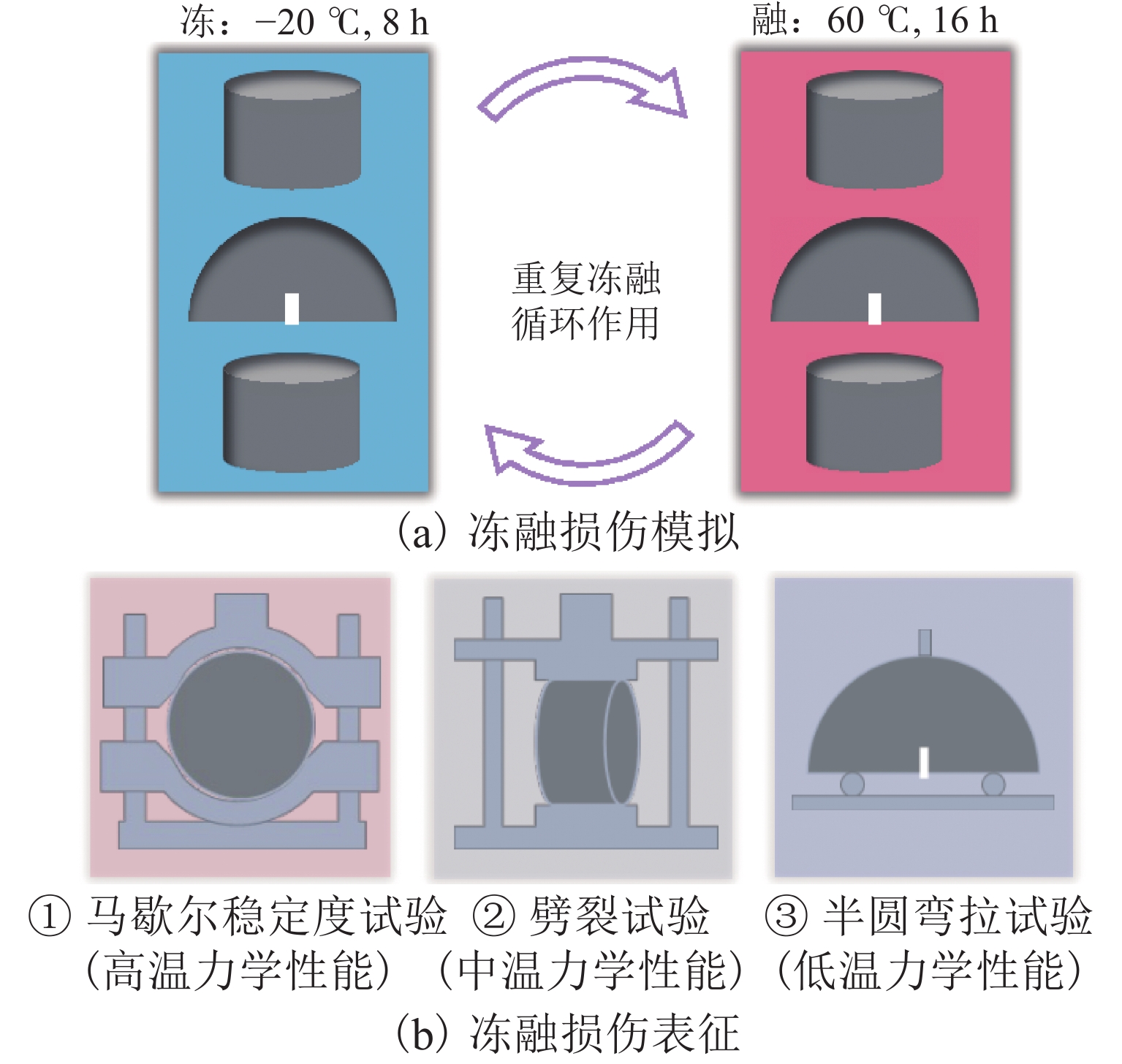Freeze-Thaw Damage Evolution Model of Asphalt Concrete for Waterproofing Layer in High-Speed Railways
-
摘要:
为研究高速铁路防水封闭层用沥青混凝土(简称铁路沥青混凝土)的冻融损伤演化,制备了选用不同沥青和不同目标级配的4种聚合物复合改性铁路沥青混凝土,分析重复冻融循环作用下多温域宏观力学性能的劣化规律. 构建针对冻融损伤演化模型,并对反复冻融循环作用下的损伤度进行计算. 研究发现:4种铁路沥青混凝土在10次冻融循环作用后,各项力学性能指标的残留率均在80%以上;低温断裂能指标对冻融循环次数的增加最为敏感,更能及时反映铁路沥青混凝土的力学性能劣化;基于统计可靠度理论构建的铁路沥青混凝土冻融损伤演化模型的拟合优度值均接近0.99.
Abstract:The freeze-thaw damage evolution of asphalt concrete for waterproofing layer in high-speed railways (shorted as railway asphalt concrete) was investigated. Four kinds of composite polymerized railway asphalt concrete were prepared with different asphalt binders and aggregate gradations, and the deterioration of macro mechanical properties in multiple temperature domains under repeated freeze-thaw cycles was evaluated. Models of freeze-thaw damage evolution for railway asphalt concrete were constructed, and the damage degree under the action of repeated freeze-thaw cycles was calculated. The results show that the retained rate of mechanical properties of the four kinds of railway asphalt concrete is still above 80% after 10 freeze-thaw cycles. The low-temperature fracture energy index is the most sensitive to freeze-thaw cycles, which can timely reflect the deterioration of mechanical properties of railway asphalt concrete. The goodness of fit of all freeze-thaw damage evolution models for railway asphalt concrete that are constructed through statistical reliability theory is nearly 0.99.
-
Key words:
- high-speed railway /
- waterproofing /
- asphalt concrete /
- freeze-thaw cycle /
- damage evolution model
-
高速铁路基础设施在服役期限内不断面临着冻融循环、极低温和强暴雨等恶劣环境因素的挑战,尤其是在高寒区和季冻区等特殊气候区[1]. 这易造成高铁路基的含水率在短时间内剧烈波动,引发路基沉降和翻浆等病害,进而影响高速铁路的服役安全性和高铁列车的行驶安全性[2-3]. 因此,在我国高速铁路设计服役寿命长达60年的情况下,如何保证高铁路基的服役耐久性成为了一个重要课题.
不少学者对此开展了研究,并提出多种应对策略. 其中一个措施便是在高铁基床表层和底座板之间铺筑一层防水封闭层,以有效阻断路基渗水侵蚀[4-5]. 目前,已有多项研究提出了包括全断面型和自密实型在内的2类沥青混凝土防水封闭层 [6-9]. 该种新型沥青混凝土防水封闭层兼具优良的防水封闭性、低温韧性和施工便捷性,应用优势显著,并且已在哈齐客专、武广高铁和京张高铁等多条线路中实现了初步应用[10-12].
相较于传统的水泥混凝土防水封闭层,沥青混凝土防水封闭层已展现出优越的工程性能,但恶劣的气候条件仍对其服役耐久性构成极大挑战,尤其是冻融循环的重复交替作用[13-17]. 然而,现有研究对高速铁路防水封闭层用沥青混凝土(简称铁路混凝土)在长服役期限内的冻融损伤演化行为关注较少,同时,缺乏对于重复冻融循环过程中铁路沥青混凝土力学性能劣化规律的研究. 本文针对以上问题开展研究,重点分析在冻融循环作用下铁路沥青混凝土的力学性能劣化规律,研究其在服役寿命周期内的冻融损伤演化特性,并进行损伤演化建模分析,以更科学地指导铁路沥青混凝土的材料设计及其在冻融循环作用下的服役耐久性验证.
1. 原材料与试验方法
1.1 原材料
为保证铁路沥青混凝土的服役耐久性,实际工程中通常选用聚合物改性沥青胶结料. 本文选用具有代表性的2种高性能聚合物复合改性沥青:SBS (styrene-butadiene-styrene)/高黏剂复合改性沥青(沥青A)、SBS/预处理胶粉复合改性沥青(沥青B),选用玄武岩和石灰岩分别作为粗集料和细集料.
选用AC13和AC10 2种级配作为铁路沥青混凝土的目标级配. 公路工程设计要求沥青混合料的目标空隙率在4%左右,渗透系数一般在10−3~10−4,对其防水性能要求不高. 考虑到高速铁路防水封闭层更注重沥青混凝土的防水性能,要求其渗透系数一般不大于 5×10−5,因此,将铁路沥青混凝土的目标空隙率选定为2%,并以此为主要控制指标确定最佳沥青用量,以实现优异的防水封闭性能[16 -17]. 最终AC13和AC10 2种级配的最佳沥青用量分别确定为5.5%和5.8%. 制备得到4种选用不同沥青和不同目标级配的铁路沥青混凝土试件,分别命名为A-AC13、A-AC10、B-AC13和B-AC10. 其中,A-AC13表示选用沥青A和级配AC13制备的铁路沥青混凝土,其余类推.
1.2 试验方法
本研究的整体试验方案如图1所示.
采用重复冻融循环试验模拟高铁沥青混凝土防水封闭层在服役期间所受到的冻融循环作用. 将铁路沥青混凝土试件放入常温(25 ℃)水槽中恒温水浴24 h,模拟高速铁路防水封闭层服役过程中的潮湿环境. 在每次冻融循环中,先将水浴完的铁路沥青混凝土试件放入低温 −20 ℃的冰柜中冷冻16 h,再置于高温60 ℃的水槽中解融8 h,分别模拟高速铁路沥青混凝土防水封闭层在冬季平均极端低温下的冷冻过程和在夏季太阳辐射下极端高温作用下的解融过程. 每个铁路沥青混凝土试件均进行20次冻融循环处理,且分别在第5、10、15、20次冻融循环后取出试件,进行多项力学性能测试(每个试件至少进行4次重复试验).
采用X射线CT扫描系统. 观测重复冻融循环前后铁路沥青混凝土试件的内部结构变化. 测试过程中,电压为205 kV, X射线管电流为35 mA,垂直间距为0.09 mm,水平分辨率为0.002 mm/像素.
采用马歇尔稳定度试验测试铁路沥青混凝土的高温力学性能. 首先,将马歇尔试件置于温度60 ℃的恒温水槽中保温30 min,同时,将马歇尔试验仪的上下压头放入烘箱中,以达到与试件相同的温度. 然后,启动加载设备,加载速度为50 mm/min. 试验结束后,读取马歇尔稳定度.
采用劈裂试验评价铁路沥青混凝土的中温力学性能. 将马歇尔试件置于温度25 ℃的恒温水槽中保温30 min,随后,取出试件,迅速置于试验台的夹具中安放稳定. 试验过程中采用50 mm/min的加载速率向试件加载至破坏,读取试验荷载的最大值,并计算劈裂强度.
采用低温半圆弯拉试验研究铁路沥青混凝土的低温力学性能. 制备直径150 mm,厚度50 mm,底部中间带有深度10 mm开口的半圆形沥青混凝土试样. 采用MTS-810材料试验系统,半圆形试样受三点弯曲载荷结构,加载速率为5 mm/min,试验温度为 −10 ℃,测定并自动记录荷载-位移曲线. 同时,选用断裂能和断裂韧性作为低温力学性能评价指标.
断裂能Gf表示铁路沥青混凝土低温断裂过程中所需的总能量,如式(1)所示.
Gf=WfAlig=∫Pudu(r−a)T, (1) 式中:Wf为断裂功,Alig为断裂面的截面积,Pu为所施加的荷载,u为施加荷载位置处的位移,r为半圆试件的半径,a为开口深度,T为半圆试件的厚度.
断裂韧性KIC表征铁路沥青混凝土在低温断裂过程中吸收能量的内在固有能力,如式(2)所示.
KIC=YI(0.8)σ0√πa, (2) YI(0.8)=4.782−1.219(ar)+0.063e7.045ar, (3) σ0 = Pc2rT, (4) 式中:YI(0.8)为标准模式Ⅰ断裂的应力强度因子,σ0为最大荷载对应的应力值,Pc为试验过程中的最大荷载值.
2. 试验结果与分析
2.1 冻融损伤演化行为
使用4种铁路沥青混凝土,研究在高、中、低3个不同温度范围内冻融循环中的力学性能劣化规律,以表征其冻融损伤演化行为. 所测得的各力学性能指标及其在冻融循环后的残留率分别如表1和图2所示. 图2阴影区域的2条边线分别代表对应的80%和85%的残留率阈值.
表 1 铁路沥青混凝土在冻融循环作用下的多温域力学性能劣化规律Table 1. Deterioration of mechanical properties of railway asphalt concrete in multiple temperature domains under freeze-thaw cycles铁路沥青混
凝土类型冻融循环
次数/次高温马歇尔稳定度/kN 中温劈裂强度/MPa 低温 断裂能/(J·m−2) 断裂韧性/(N·mm−1) A-AC13 0 15.17 1.332 1613.31 45.04 5 14.53 1.286 1544.35 43.83 10 12.42 1.204 1425.63 41.79 15 11.41 1.235 1387.06 41.49 20 11.52 1.246 1283.29 41.35 A-AC10 0 16.96 1.370 1775.90 47.77 5 15.23 1.357 1550.55 46.19 10 13.85 1.282 1457.35 46.28 15 13.95 1.317 1300.80 45.26 20 11.95 1.350 1190.75 44.56 B-AC13 0 13.64 1.100 1816.15 50.20 5 12.97 1.020 1624.46 49.80 10 10.36 0.957 1561.45 47.02 15 9.99 0.997 1466.08 47.70 20 9.79 1.021 1362.22 45.66 B-AC10 0 14.76 1.118 2017.68 52.17 5 13.28 1.063 1898.64 48.68 10 11.50 0.986 1691.99 47.22 15 10.76 1.030 1572.85 46.91 20 10.76 1.079 1498.54 48.04 1) 高温力学性能劣化规律:各种铁路沥青混凝土的马歇尔稳定度均与冻融循环次数负相关. 由于冻融循环作用降低了沥青与集料的界面黏结强度,并导致沥青胶结料的内部损伤,从而在高温(60 ℃)条件下表现为马歇尔稳定度降低.
2) 中温力学性能劣化规律:4种铁路沥青混凝土的中温(25 ℃)劈裂强度在前10 次重复冻融循环作用下显著下降. 而当冻融循环次数继续增加时,其劈裂强度却反向增加. 在冻融循环过程中,沥青-集料黏结作用在水分渗透作用下发生弱化(即湿度弱化效应),同时,沥青也受到高温处理过程中的温度硬化作用[18]. 因此,当冻融循环次数增加,沥青的温度硬化效应对铁路沥青混凝土的影响可能逐步大于沥青-集料界面黏结破坏的影响. 这在宏观上表现出中温测试条件下劈裂强度先下降后上升[18]. 这种性能反弹现象也可能是冻融循环次数不够或劈裂强度测试值离散度过高所导致的.
3) 低温力学性能劣化规律:受到重复冻融循环作用的影响,其低温(−10 ℃)断裂能和断裂韧性均显著降低. 这是由于重复冻融循环作用时,水分侵入铁路沥青混凝土内部,随后发生重复的体积膨胀和收缩,使得铁路沥青混凝土内部结构损伤(见图3),沥青-集料界面黏结性能削弱,并使沥青胶结料发生内聚力损失,从而宏观上表现为低温抗裂性能随着冻融循环次数增加而不断下降.
总体而言,虽然铁路沥青混凝土力学性能出现一定的劣化,但是在10次重复冻融循环之后,各项性能指标的残留率基本均能维持在80%以上. 同时,根据《公路工程沥青及沥青混合料试验规程》(JTG E20—2011)[19],沥青混合料在仅1次冻融循环后,力学性能损失率在20%(15%)以内,即可认为其抗冻融损伤能力满足要求. 因此,凭借所采用的高性能聚合物复合改性沥青胶结料和低空隙率设计方法,铁路沥青混凝土表现出优异的抗冻融损伤能力. 其中,低温断裂能指标对冻融循环最为敏感,即更能及时反映出重复冻融循环过程中铁路沥青混凝土力学性能的劣化程度. 在冻融循环次数提高的过程中,中温劈裂强度、低温断裂韧性均有降低的趋势,在达到一定程度之后基本保持稳定,甚至略有反升.
另外,铁路沥青混凝土在重复冻融循环作用下各项力学性能指标之间的统计相关性矩阵(相关性系数与显著性)如图4所示. 可以看出,高温马歇尔稳定度与中温劈裂强度、低温断裂能之间均具有显著的相关性. 同样,低温断裂韧性也与这两项性能指标显著相关,尤其是低温断裂韧性与低温断裂能之间存在极强的相关性.
2.2 冻融损伤演化模型
受到诸多外部因素的影响,沥青混凝土将出现一定的损伤,该过程实质上均可视为材料劣化的过程. 尽管在不同环境因素影响下,沥青混凝土所呈现的损伤特征存在一定的差异性,然而,各种材料在劣化时均存在损伤的共性,据此可以对损伤演化模型进行设计,使其保持良好的通用性. 基于上述分析,可以直接在宏观表象层次构建损伤演化模型. 本文基于统计可靠度理论,从力学性能测试数据出发,构建铁路沥青混凝土的冻融损伤演化模型[20-23].
2.2.1 模型假设
一般而言,冻融循环过程中铁路沥青混凝土试件在水溶液内完全浸入之后,试件在各个方向会受到冻融作用(边界条件一致). 所以,在研究冻融循环对于铁路沥青混凝土的影响时,可以构建对应的立方体模型(六面等损伤梯度G). 假设条件如下所示[20-23]:
假设Ⅰ:铁路沥青混凝土在宏观上可视为连续的均匀体.
假设Ⅱ:各个边界的冻融侵蚀条件是一致的,与冻融有关的等损伤梯度G自各个面朝着内部发展,所以,内部到边界最短距离一致的微元体始终服从同一损伤演化规律.
假设Ⅲ:铁路沥青混凝土内部各微元件的冻融损伤程度F(t)与冻融循环时间t (可换算为冻融循环次数)之间的关系均服从Weibull分布,如式(5)所示.
F(t)=1−e−(λt)α, (5) 式中:λ为尺度因子,α为Weibull分布的形状因子.
显然,当t=0时,F(t)=0,表示铁路沥青混凝土尚未受到损伤;当t→∞时,F(t)=1,表示铁路沥青混凝土已被完全损坏.
假设Ⅳ:结合Weibull分布特征可知,当内部各点受到相同不利损伤条件的影响时,对应的失效曲线形状也是相同的,即形状因子α是相同的.
2.2.2 模型推导
已知(x,y,z)为混凝土内部的某坐标点,在该位置取微元体,f(x,y,z;t)为点元件在时刻t出现损伤破坏的概率密度函数. 而在时刻t微元体破坏的体积为V(x,y,z;t),由于其符合空间Poisson分布,即可确定微单元和点元件的相关性.
根据假设Ⅱ,尺度因子为
λ(x,y,z)=λ(|x|,|y|,|z|). (6) 同时,以Poisson 分布的平均发生率P表示点元件在时刻t破坏的概率,如式(7)所示.
P=f(x,y,z;t)dζdηdσ, (7) 式中:dζ、dη和dσ分别为图5中微元体内部任意部位的点元件(为一空间片段)在不同空间尺度上微分.
由于V(x,y,z;t)服从空间Poisson分布,其数学期望为
E(V(x,y,z;t))=nP=dxdydzdζ−1dη−1dσ−1×f(x,y,z;t)dζdηdσ=f(x,y,z;t)dxdydz, (8) 式中:n为空间区域中样本点的总个数.
整个区域的受损体积V如式(9)所示,进而定义损伤度D如式(10)所示.
V = ∭ (9) D{\text{ = }}\frac{V}{{{V_0}}}, (10) 式中: {V_0} 为原单元区域体积.
根据式(5)~(10),可得出铁路沥青混凝土的损伤演化方程为
D = \frac{{\displaystyle\iiint\limits_{{V_0}} {\alpha {{\left( {\lambda t} \right)}^{\alpha - 1}}{{\rm{e}}^{ - {{\left( {\lambda t} \right)}^\alpha }}}{\rm{d}}x{\rm{d}}y{\rm{d}}}}{\textit{z}}}{{{V_0}}}. (11) 2.2.3 数值算法
在计算之前需要先进行空间离散化处理的过程. 对于三轴等损伤梯度的体模型(见图5),针对每个边进行 N (偶数)等划分. {N_i} 为距离模型边缘最小距离一致的第i层单元数,如式(12)所示.
{N_i}{\text{ = }}6{N^2} - 24iN + 24{i^2} - 12N + 24i + 8, (12) 式中:i{\text{ = }}0,1, \cdots , {N / 2} - 1.
按类似推导,设第i层单元在时刻t发生破坏的分布函数为 {F_i}\left( t \right) . 另外,样本点不多的情况下,即可实现Poisson分布到Bernoulli分布的转换. 在t时第i层破坏的单元数目为 {N_i} ,这一事件 {\varphi _i} 的期望为
E\left( {{\varphi _i}} \right) = {N_i}{F_i}\left( t \right). (13) 根据假设Ⅲ可得
{F_i}\left( t \right) = 1 - {{\rm{e}}^{ - {{\left( {{\lambda _i}t} \right)}^\alpha }}}, (14) 式中: {\lambda _i} 为第i层单元的尺度因子,可采用线性或非线性公式来模拟.
在网络划分比较精细,并通过线性公式对 {\lambda _i} 进行模拟时,则可以不考虑微单元尺寸的影响,此时,
{\lambda _i}{\text{ = }}{\lambda _0}-\frac{{2i\nu }}{{N - 2}}, (15) 式中: {\lambda _0} 为均匀尺度因子; \nu 为梯度因子;当i = 0 时,最外层 {\lambda _i} = {\lambda _0} ,当i = {N / 2} - 1时,最内层 {\lambda _i} = {\lambda _0}-\nu .
在时刻t单元发生破坏事件 \omega 的数学期望为
E\left( \omega \right){\text{ = }}\sum\limits_{i = 0}^{\tfrac{N}{2} - 1} {E\left( {{\varphi _i}} \right)} = \sum\limits_{i = 0}^{\tfrac{N}{2} - 1} {{N_i}{F_i}\left( t \right)}. (16) 相应的区域冻融损伤期望为
\begin{split} & E\left( D \right){\text{ = }}\frac{{E\left( \omega \right)}}{{{V_0}}} = \\ &\quad {N^{ - 3}}\sum\limits_{i = 0}^{\tfrac{N}{2} - 1} {{N_i}} \left[ 1 - {\rm{exp}}\left( - {{\left( {\lambda _0}t - \dfrac{{ivt}} {N/2 - 1} \right)}^\alpha }\right) \right]. \end{split} (17) n 次冻融循环之后的试件损伤度为
{D_n}{\text{ = }}\frac{{{E_0} - {E_n}}}{{{E_0}}}, (18) 式中: {E_0} 为冻融前铁路沥青混凝土试件的初始力学性能指标值, {E_n} 为第 n 次冻融循环后铁路沥青混凝土试件的残留力学性能指标值.
2.2.4 模型构建
在模型构建过程中需要先结合宏观力学性能测试结果,并根据式(18)计算得到不同冻融循环次数后的损伤度 {D_n} ;随后,将 t 和 {D_n} 同时代入式(17)中,结合最小二乘法,推导出冻融损伤演化模型的3个参数(\alpha 、{\lambda _0}、v ),进而确定模型.
值得一提的是, N \gt 10 时,便能较好地满足模型精度要求,同时不会导致迭代次数过多[19-20]. 取 N{\text{ = 64}} ,选取对冻融损伤敏感性最高的低温断裂能指标计算损伤度,对其20次冻融循环过程中的各数据点进行拟合,利用MATLAB确定各模型参数并计算判定系数(即拟合优度),以评价冻融损伤模型精度,结果见表2和图6.
表 2 铁路沥青混凝土冻融损伤演化模型参数拟合结果Table 2. Fitted parameters of freeze-thaw damage evolution model of railway asphalt concrete沥青混凝土类型 \alpha {\lambda _0} \nu /×10−7 判定系数 A-AC13 1.0327 0.01151 0.1 0.9841 A-AC10 0.7311 0.01359 0.1 0.9859 B-AC13 0.7541 0.00915 0.1 0.9888 B-AC10 0.9902 0.01290 0.1 0.9827 根据得到的结果可知,4种铁路沥青混凝土的冻融损伤演化模型的预测值与实测值之间的判定系数均接近0.99,表明模型精度高. 3个模型参数具有较显著的规律性,并随着铁路沥青混凝土类型的不同表现出一定差异性,能较好地区分不同类型铁路沥青混凝土的内部冻融损伤演化行为.
首先,形状因子 \alpha 决定Weibull分布曲线的形状,表征铁路沥青混凝土内部的各点位随冻融循环的损伤特性. 不同类型铁路沥青混凝土的 \alpha 值存在一定的差异性,意味着其在经受同种不利冻融循环作用时,同种力学性能的劣化特性也表现出一定的差异性.
其次,均匀尺度因子 {\lambda _0} 可以描述不同点位对于冻融循环作用的抵抗能力大小,且其值与铁路沥青混凝土的冻融损伤抵抗能力呈负相关. 根据表2中的信息,从低温力学性能指标的角度而言,选用聚合物复合改性沥青B (即SBS/胶粉复合改性沥青)或选用级配AC-13的铁路沥青混凝土通常具备较强的抗冻融损伤能力.
最后,梯度因子 \nu 表征在冻融循环时不同点位损伤情况的差异性大小. 通常情况下,如果该指标的绝对值较低,则意味着这种差异性更小,即各个点位的损伤发展不存在显著的差异性. 而根据其值的正负情况可以对损伤发展的方向进行确定. 如果其值为正,表明冻融损伤是由外而内发展,反之,则是由内而外传播. 根据表2中的信息可知,对于4种不同类型的铁路沥青混凝土,该参数的绝对值均接近于0,且均为正值,因此,可认为铁路沥青混凝土在冻融循环过程中受到由外向内的均匀损伤,且内部各个点位的损伤发展基本保持同步.
3. 结 论
本研究采用低孔隙率配合比设计方法,制备了4种聚合物复合改性铁路沥青混凝土,并重点分析其受到冻融循环作用时的损伤演化特征. 总结如下:
1) 4种铁路沥青混凝土在10次冻融循环作用后,各力学性能的残留率基本均能维持在80%以上,表现出优异的抗冻融损伤能力.
2) 低温断裂能指标对冻融循环最为敏感,更能及时反映重复冻融过程中铁路沥青混凝土力学性能的劣化程度. 而中温劈裂强度、低温断裂韧性在冻融循环过程中先表现为减小的趋势,在达到一定程度之后基本保持稳定,甚至略有反升.
3) 构建冻融损伤演化模型将铁路沥青混凝土的宏观力学性能劣化与结构损伤扩展进行融合,模型拟合优度较高,均接近于0.99,因此,可实现对冻融损伤度的精准预测.
4) 铁路沥青混凝土在冻融循环过程中受到由外向内的均匀同步损伤,选用SBS/胶粉改性沥青或级配AC13的铁路沥青混凝土通常具备较强的抗冻融损伤能力.
-
表 1 铁路沥青混凝土在冻融循环作用下的多温域力学性能劣化规律
Table 1. Deterioration of mechanical properties of railway asphalt concrete in multiple temperature domains under freeze-thaw cycles
铁路沥青混
凝土类型冻融循环
次数/次高温马歇尔稳定度/kN 中温劈裂强度/MPa 低温 断裂能/(J·m−2) 断裂韧性/(N·mm−1) A-AC13 0 15.17 1.332 1613.31 45.04 5 14.53 1.286 1544.35 43.83 10 12.42 1.204 1425.63 41.79 15 11.41 1.235 1387.06 41.49 20 11.52 1.246 1283.29 41.35 A-AC10 0 16.96 1.370 1775.90 47.77 5 15.23 1.357 1550.55 46.19 10 13.85 1.282 1457.35 46.28 15 13.95 1.317 1300.80 45.26 20 11.95 1.350 1190.75 44.56 B-AC13 0 13.64 1.100 1816.15 50.20 5 12.97 1.020 1624.46 49.80 10 10.36 0.957 1561.45 47.02 15 9.99 0.997 1466.08 47.70 20 9.79 1.021 1362.22 45.66 B-AC10 0 14.76 1.118 2017.68 52.17 5 13.28 1.063 1898.64 48.68 10 11.50 0.986 1691.99 47.22 15 10.76 1.030 1572.85 46.91 20 10.76 1.079 1498.54 48.04 表 2 铁路沥青混凝土冻融损伤演化模型参数拟合结果
Table 2. Fitted parameters of freeze-thaw damage evolution model of railway asphalt concrete
沥青混凝土类型 \alpha {\lambda _0} \nu /×10−7 判定系数 A-AC13 1.0327 0.01151 0.1 0.9841 A-AC10 0.7311 0.01359 0.1 0.9859 B-AC13 0.7541 0.00915 0.1 0.9888 B-AC10 0.9902 0.01290 0.1 0.9827 -
[1] LIN Z J, NIU F J, LI X L, et al. Characteristics and controlling factors of frost heave in high-speed railway subgrade, Northwest China[J]. Cold Regions Science and Technology, 2018, 153: 33-44. doi: 10.1016/j.coldregions.2018.05.001 [2] HUANG J J, SU Q A, LIU T, et al. Behavior and control of the ballastless track-subgrade vibration induced by high-speed trains moving on the subgrade bed with mud pumping[J]. Shock and Vibration, 2019, 2019: 1-14. [3] 杨国涛. 高寒地区高速铁路路基基床表层冻胀机理与轨道平顺性控制研究[D]. 北京: 北京交通大学, 2020. [4] XIAO X, CAI D G, LOU L W, et al. Application of asphalt based materials in railway systems: a review[J]. Construction and Building Materials, 2021, 304: 124630.1-124630.22. [5] FANG M J, HU T, ROSE J G. Geometric composition, structural behavior and material design for asphalt trackbed: a review[J]. Construction and Building Materials, 2020, 262: 120755.1-120755.13. [6] CHEN X H, TAO T Q, YANG G T, et al. Long-lasting waterproofing solution for the subgrade of high-speed railway in cold region[J]. Journal of Testing and Evaluation, 2019, 47(3): 20180046.1-20180046.13. [7] LUO Q, FU H, LIU K W, et al. Monitoring of train-induced responses at asphalt support layer of a high-speed ballasted track[J]. Construction and Building Materials, 2021, 298: 123909.1-123909.14. [8] 曾杰. 季冻区沥青混凝土强化基床表层轨下基础结构计算方法与耐久性研究[D]. 成都: 西南交通大学, 2018. [9] 刘亚坤. 季冻区高速铁路无砟轨道沥青混凝土强化基床力学特性研究[D]. 成都: 西南交通大学, 2018. [10] LIU S, YANG J, CHEN X H, et al. Application of mastic asphalt waterproofing layer in high-speed railway track in cold regions[J]. Applied Sciences, 2018, 8(5): 667.1-667.16. [11] YANG E H, WANG K C P, LUO Q A, et al. Asphalt concrete layer to support track slab of high-speed railway[J]. Transportation Research Record: Journal of the Transportation Research Board, 2015, 2505(1): 6-14. doi: 10.3141/2505-02 [12] ZHOU J E, CHEN X H, FU Q H, et al. Dynamic responses of asphalt concrete waterproofing layer in ballastless track[J]. Applied Sciences, 2019, 9(3): 375.1-375.19. [13] XIAO X, LI J, CAI D G, et al. Evolution evaluation of high-speed railway asphalt concrete waterproofing layer during laboratory freeze-thaw cycles[J]. Construction and Building Materials, 2022, 324: 126258.1-126258.12. [14] XU G, ZHOU J, CHEN X H, et al. Temperature features of the asphalt concrete waterproofing layer on high-speed railway in cold regions[J]. Construction and Building Materials, 2021, 305: 124665.1-124665.11. [15] LIU S, CHEN X H, YANG J, et al. Numerical study and in situ measurement of temperature features of asphalt supporting layer in slab track system[J]. Construction and Building Materials, 2020, 233: 117343.1-117343.11. [16] 徐刚. 高速铁路沥青混凝土防水封闭层细观特性演变研究[D]. 南京: 东南大学, 2019. [17] 冷严. 季冻区高速铁路沥青混凝土强化基床表层材料制备技术与综合性能试验研究[D]. 成都: 西南交通大学, 2018. [18] 任敏达,丛林,孙思林,等. 多次孔隙水压作用下沥青混合料性能演化试验[J]. 吉林大学学报(工学版),2021,51(4): 1277-1286. doi: 10.13229/j.cnki.jdxbgxb20200225REN Minda, CONG Lin, SUN Silin, et al. Experiment of performance evolution of asphalt mixtures under multiple pore water pressure cycles[J]. Journal of Jilin University (Engineering and Technology Edition), 2021, 51(4): 1277-1286. doi: 10.13229/j.cnki.jdxbgxb20200225 [19] 中华人民共和国交通运输部. 公路工程沥青及沥青混合料试验规程: JTG E20—2011[S]. 北京: 人民交通出版社, 2011. [20] CHENG Y C, WANG W S, GONG Y F, et al. Comparative study on the damage characteristics of asphalt mixtures reinforced with an eco-friendly basalt fiber under freeze-thaw cycles[J]. Materials, 2018, 11(12): 22488.1-22488.17. [21] 关宇刚,孙伟,缪昌文. 基于可靠度与损伤理论的混凝土寿命预测模型Ⅰ:模型阐述与建立[J]. 硅酸盐学报,2001,29(6): 530-534. doi: 10.3321/j.issn:0454-5648.2001.06.005GUAN Yugang, SUN Wei, MIAO Changwen. One service-life prediction model for the concrete based on the reliability and damage theoriesⅠ: narration and establishment of the model[J]. Journal of the Chinese Ceramic Society, 2001, 29(6): 530-534. doi: 10.3321/j.issn:0454-5648.2001.06.005 [22] 张启鹏,顾兴宇,丁济同,等. 沥青混合料蠕变损伤模型与损伤演化[J]. 交通运输工程学报,2021,21(5): 104-113. doi: 10.19818/j.cnki.1671-1637.2021.05.009ZHANG Qipeng, GU Xingyu, DING Jitong, et al. Creep damage model and damage evolution of asphalt mixtures[J]. Journal of Traffic and Transportation Engineering, 2021, 21(5): 104-113. doi: 10.19818/j.cnki.1671-1637.2021.05.009 [23] 张峰,李术才,李守凯. 混凝土随机冻融损伤三维预测模型[J]. 土木建筑与环境工程,2011,33(1): 31-35,134.ZHANG Feng, LI Shucai, LI Shoukai. Three-dimensional random damage prediction model of concrete caused by freeze-thaw[J]. Journal of Civil, Architectural & Environmental Engineering, 2011, 33(1): 31-35,134. 期刊类型引用(1)
1. 姚华彦,王旭洋,拓明阳,孙磊,扈惠敏. 盐冻融循环对玄武岩纤维沥青混合料抗裂性能及微观结构的影响. 材料导报. 2024(S2): 640-645 .  百度学术
百度学术其他类型引用(1)
-






 下载:
下载:






 下载:
下载:
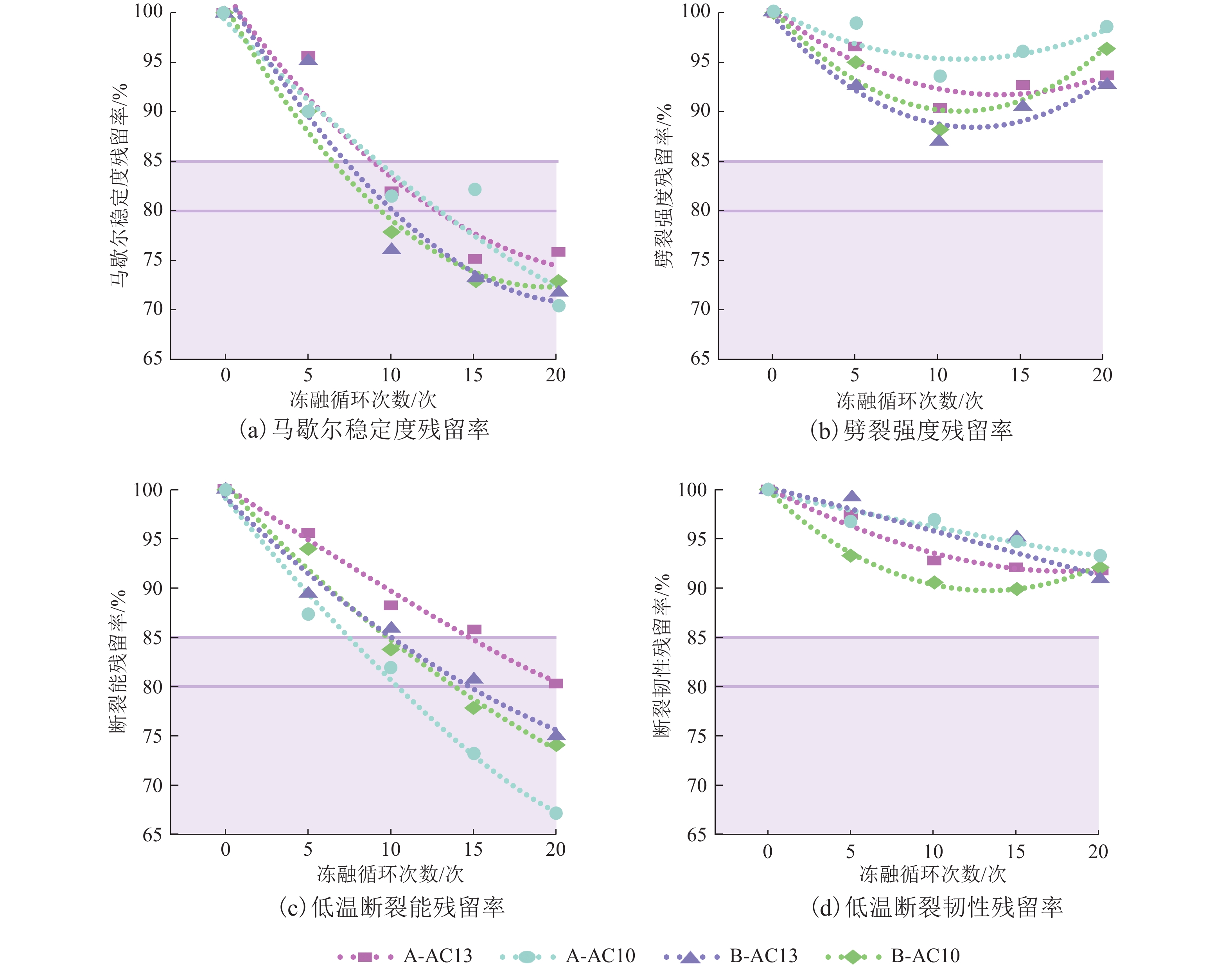
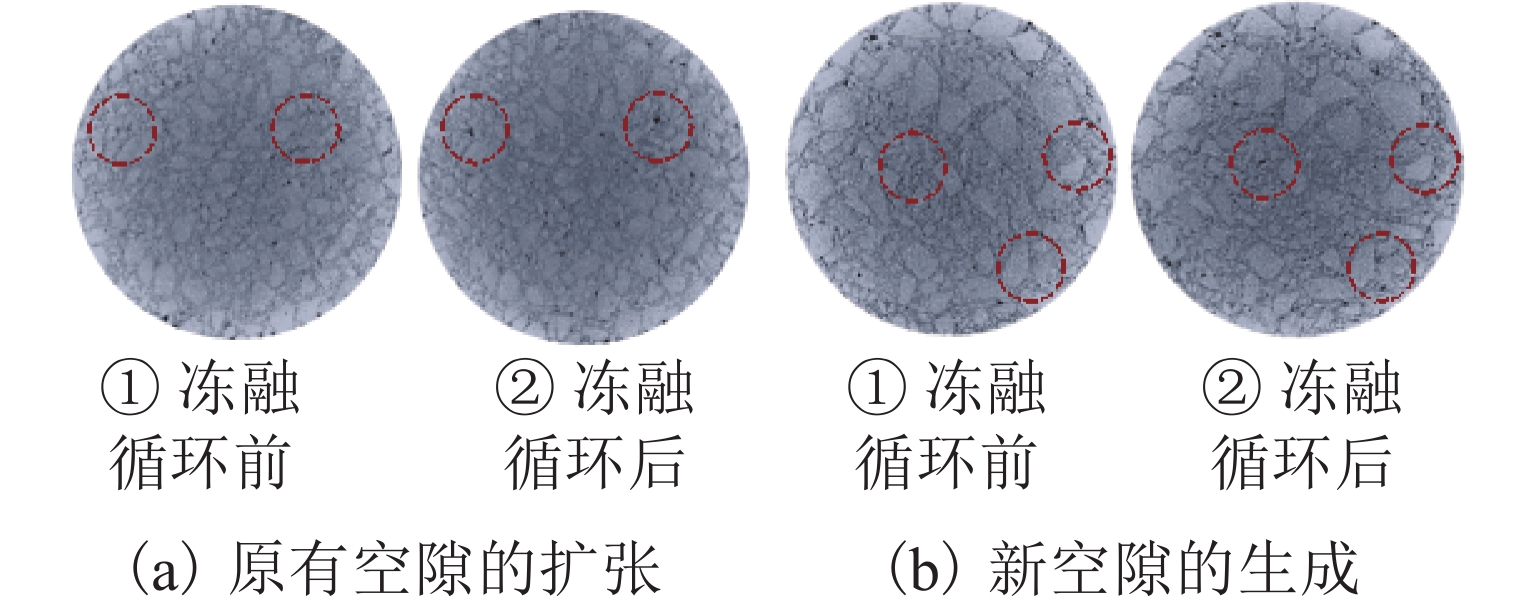
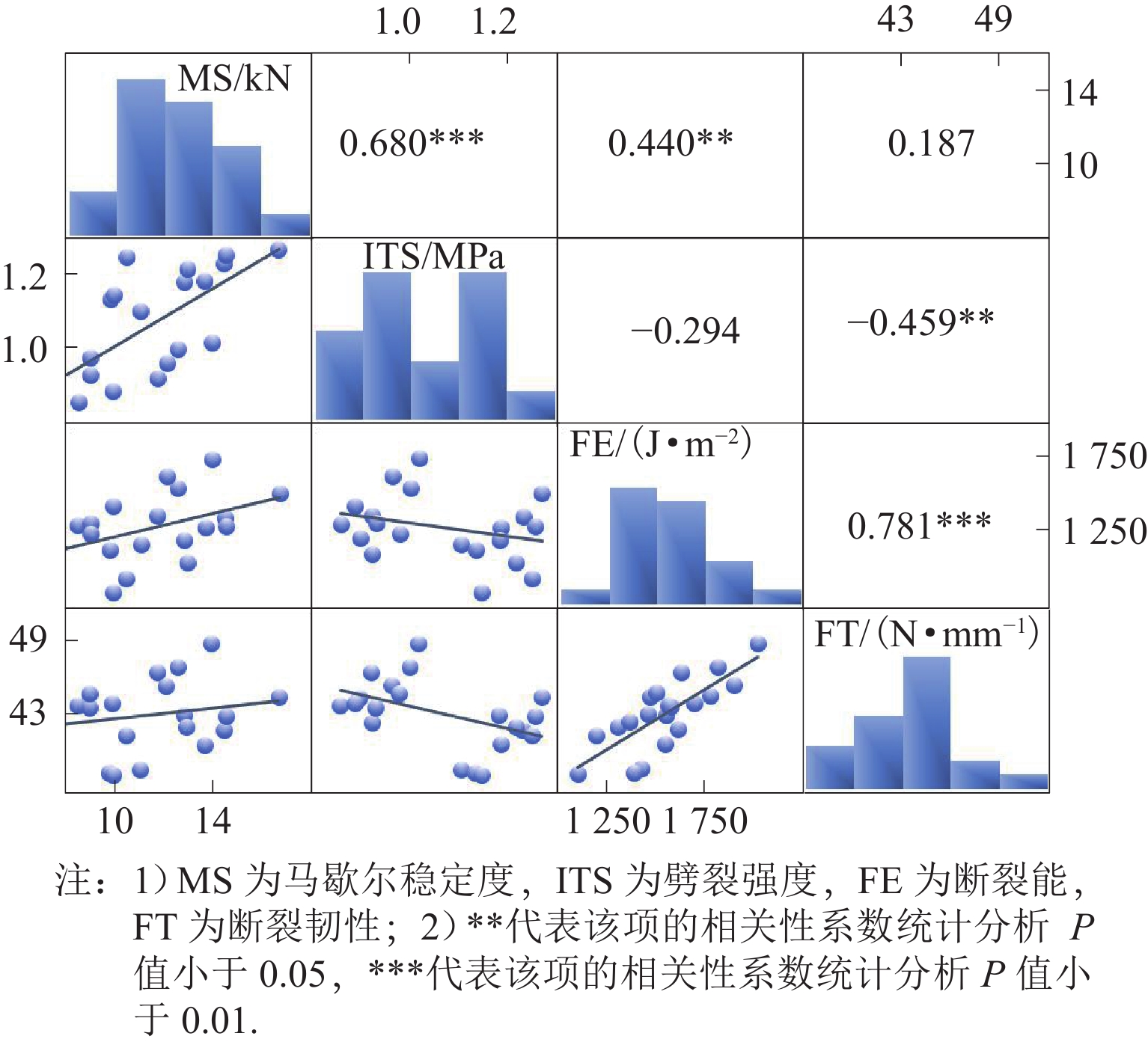
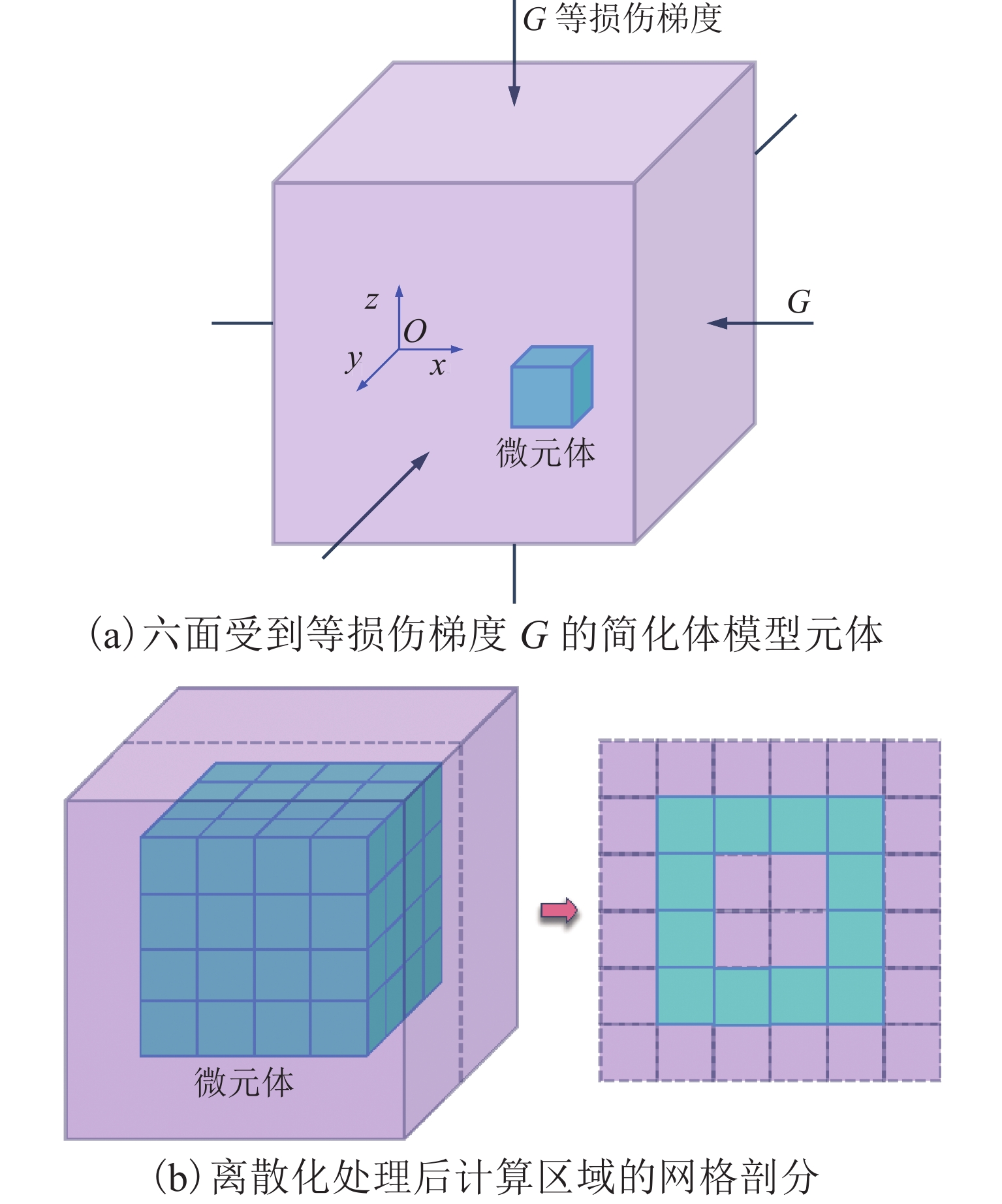
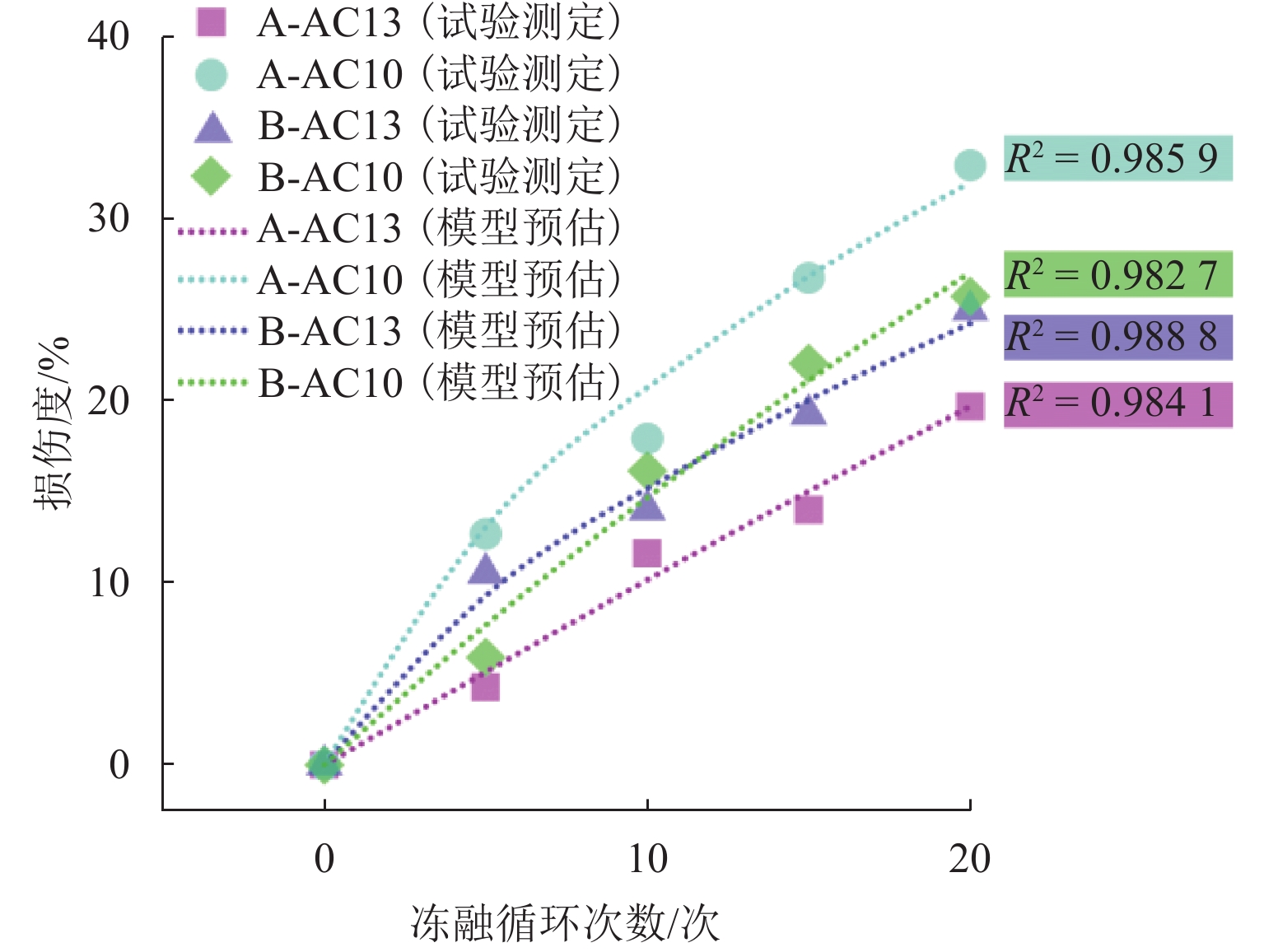
 百度学术
百度学术

